LAB REPORT
Science and Technology Making Headlines
Nov. 13, 2015

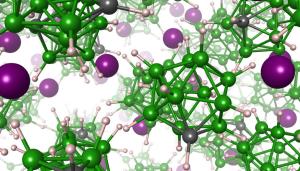
Jianchao Ye shows off an improved lithium ion battery. Photo by Julie Russell/LLNL
Get by with a little help from hydrogen
Your cell phone battery could stay charged longer with a little help from hydrogen.
Researchers at Lawrence Livermore National Laboratory have discovered lithium ion batteries can last longer and charge faster if their electrodes are treated with hydrogen.
The breakthrough could lead to significant improvements in the performance of the batteries, which are commonly used in smartphones, digital cameras, electric cars and home energy storage systems.
Batteries have positive and negative electrodes and electrons flow between them when the battery is providing electricity or being charged. In lithium ion batteries, the binding between lithium ions and the electrode material helps determine the performance of the battery.

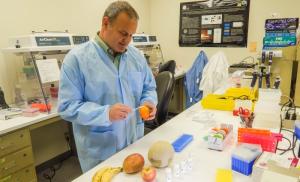
LLNL physical chemist George Farquar, who led a Lab team that invented DNATrax, demonstrates how the product can be applied to food to identify it down the food chain. Photo by Julie Russell/LLNL
Tracking the air up there
One of the most overlooked threats to human health is poor indoor air quality. Various air pollutants exist indoors, including biological pollutants, second-hand smoke, combustion pollutants and other chemicals, and they can pool in spaces with inadequate ventilation.
Determining the source of pollution is often the first step in improving air quality. Lawrence Livermore National Laboratory’s DNATrax, a safe simulant material made with non-biological DNA, can track and quantify indoor airflow.
DNATrax is a biological barcode — it leverages the diversity in nature to create unique markers with a wide range of applications in food traceability, food and pharmaceutical fraud detection, food safety and biodefense. The technology was developed at LLNL and licensed by SafeTraces (formerly DNATrek) and it is undergoing evaluations in field trials.
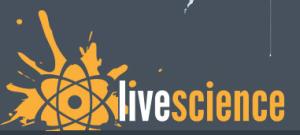
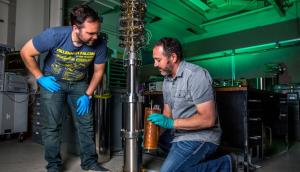
Lawrence Livermore scientists have devised a new model of dark matter.
A matter of time
Dark matter particles may have interacted extensively with normal matter long ago, when the universe was very hot, a new study suggests.
The nature of dark matter is one of the greatest mysteries in science. The invisible substance — which is detectable via its gravitational influence on "normal" matter — is thought to make up five-sixths of all matter in the universe.
Lawrence Livermore scientists have devised a new model of dark matter. It identifies it as naturally "stealthy" today, but would have been easy to see via interactions with ordinary matter in the extremely high-temperature plasma conditions that pervaded the early universe.
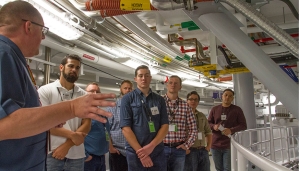
Students enrolled in the Las Positas College Engineering Technology Program recently had a chance to tour the National Ignition Facility at Lawrence Livemore National Laboratory. Photo by Julie Russell/LLNL
Vetting a new career
Ryan Kelley spent four years in the Marines as an ordinance technician for machine guns and rockets. While his military service provided him with indelible life experiences, he wasn't sure how it would translate to finding a civilian job.
Until Lawrence Livermore and Las Positas Community College stepped in. About 30 veterans, including Kelley, participate in a partnership between Las Positas Community College and Lawrence Livermore National Laboratory that helps veterans complete a two-year degree in engineering technology while establishing a pipeline of qualified candidates for the Lab and other Bay Area employees.
The partnership is in its second year and stemmed when Lab recruiters realized through the Lab's outreach efforts that many veterans re-entering the workforce struggled at finding jobs that fit their unique skill sets.

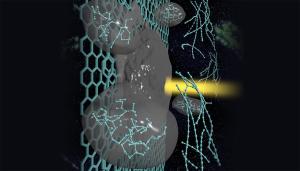
A carbyne strand forms in laser-melted graphite. Carbyne is found in astrophysical bodies and has the potential to be used in nanoelectronic devices and superhard materials. Image by Liam Krauss/LLNL
From meteorites to nanoelectronics
Lawrence Livermore scientists have investigated a way to create linear chains of carbon atoms (carbyne) from laser-melted graphite, which could have a number of novel properties, including the ability to adjust the amount of electrical current traveling through a circuit.
Carbyne is the subject of intense research because of its presence in astrophysical bodies, as well as its potential use in nanoelectronic devices and superhard materials. Its linear shape gives it unique electrical properties that are sensitive to stretching and bending, and it is 40 times stiffer than diamond. It also was found in the Murchison and Allende meteorites and could be an ingredient of interstellar dust.
Using computer simulations, LLNL scientist Nir Goldman and colleague Christopher Cannella (an undergraduate summer researcher from Caltech) initially intended to study the properties of liquid carbon as it evaporates, after being formed by shining a laser beam on the surface of graphite. The laser can heat the graphite surface to a few thousands of degrees, which then forms a fairly volatile droplet. To their surprise, as the liquid droplet evaporated and cooled in their simulations, it formed bundles of linear chains of carbon atoms.





